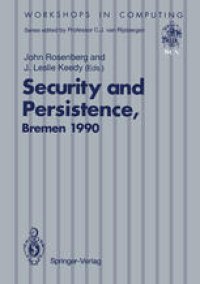
Ebook: Security and Persistence: Proceedings of the International Workshop on Computer Architectures to Support Security and Persistence of Information 8–11 May 1990, Bremen, West Germany
- Tags: Software Engineering, Processor Architectures
- Series: Workshops in Computing
- Year: 1990
- Publisher: Springer-Verlag London
- Edition: 1
- Language: English
- pdf
During a short visit to Bremen in December 1989 John Rosenberg had several discussions with me about computer architecture. Although we had previously worked together for more than a decade in Australia we had not seen each other for over a year, following my move to Bremen in 1988. Meanwhile John was spending a year on study leave at the University of St. Andrews in Scotland with Professor Ron Morrison and his persistent programming research group. From our conversations it was quite clear that John was having a most fruitful time in St. Andrews and was gaining valuable new insights into the world of persistent programming. He was very keen to explore the significance of these insights for the MONADS Project, which we had been jOintly directing since the early 1980s. MONADS was not about persistent programming. In fact it had quite different origins, in the areas of software engineering and information protection. In an earlier stage of the project our ideas on these themes had led us into the world of computer architecture and even hardware deSign, in our attempts to provide an efficient base machine for our software ideas. The most important practical result of this phase of the project had been the development of the MONADS-PC, a mini computer which would be better compared with say a V tv< 11/750 than with a personal computer, despite its unfortunate name.
This volume presents the Proceedings of the International Workshop on Computer Architecures to Support Security and Persistence of Information, which was held in Bremen, West Germany, from 8 to 11 May 1990. The papers provide state-of-the-art details of current research into topics including persistent architectures, security, capability-based addressing and operating systems. Persistent systems are systems which support the creation and manipulation of objects in a uniform manner, regardless of how long they persist. This is in direct contrast to conventional systems where temporary and permanent objects are handled by separate mechanisms. The workshop brought together researchers in the areas of persistence and security to discuss issues related to architectural support for security and, as a result, capability-based protection schemes receive considerable attention. The implications of these architectures for software, in particular operating systems and databases, is the topic of several of the papers.
This volume presents the Proceedings of the International Workshop on Computer Architecures to Support Security and Persistence of Information, which was held in Bremen, West Germany, from 8 to 11 May 1990. The papers provide state-of-the-art details of current research into topics including persistent architectures, security, capability-based addressing and operating systems. Persistent systems are systems which support the creation and manipulation of objects in a uniform manner, regardless of how long they persist. This is in direct contrast to conventional systems where temporary and permanent objects are handled by separate mechanisms. The workshop brought together researchers in the areas of persistence and security to discuss issues related to architectural support for security and, as a result, capability-based protection schemes receive considerable attention. The implications of these architectures for software, in particular operating systems and databases, is the topic of several of the papers.
Content:
Front Matter....Pages i-xviii
Front Matter....Pages 1-1
Capabilities and Security....Pages 3-8
Persistent Languages and Architectures....Pages 9-28
Front Matter....Pages 29-29
Dimensions of Addressing Schemes....Pages 31-47
Protection in Persistent Object Systems....Pages 48-66
A Model for Protection in Persistent Object-Oriented Systems....Pages 67-82
Front Matter....Pages 83-83
Charging in a Secure Environment....Pages 85-96
Algorithms for Data Encryption....Pages 97-105
Capabilities and Encryption: The Ultimate Defense Against Security Attacks ?....Pages 106-119
Front Matter....Pages 121-121
Implementing 128 Bit Persistent Addresses on 80x86 Processors....Pages 123-136
Active Memory for Managing Persistent Objects....Pages 137-154
A Layered Persistent Architecture for Napier88....Pages 155-172
An Object-Oriented Approach to Support System Reliability and Security....Pages 173-187
A Secure RISC-based Architecture Supporting Data Persistence....Pages 188-201
An Architecture Supporting Security and Persistent Object Storage....Pages 202-214
Front Matter....Pages 215-215
PUMA — A Capability-Based Architecture to Support Security and Fault Tolerance....Pages 217-228
Stability in a Persistent Store Based on a Large Virtual Memory....Pages 229-245
Stability in a Network of MONADS-PC Computers....Pages 246-256
Front Matter....Pages 257-257
Homogeneous Memory Management in the Context of the Veritos-Project....Pages 259-273
Considerations of Persistence and Security in Choices, an Object-Oriented Operating System....Pages 274-288
Front Matter....Pages 289-300
Combining Verified and Adaptive System Components Towards More Secure Computer Architectures....Pages 257-257
Mechanisms for Persistence and Security in BirliX....Pages 301-308
Front Matter....Pages 309-315
Transactions in a Segmented Single Level Store Architecture....Pages 317-317
The RelaX Transactional Object Management System....Pages 319-338
Towards New Architectures for Distributed Autonomous Database Applications....Pages 339-355
Persistence for Arbitrary C++ Data Structures....Pages 356-377
Back Matter....Pages 378-391
....Pages 393-394